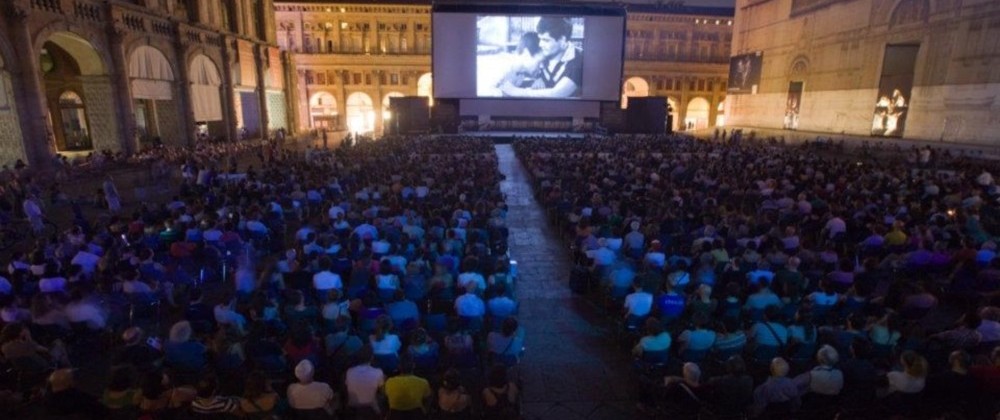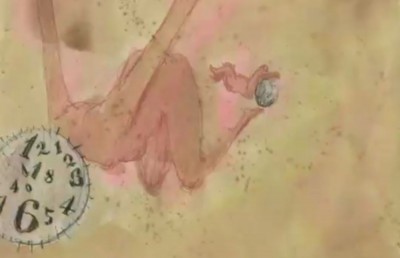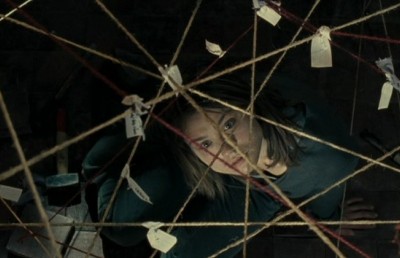“Japan Speaks Out!” at the 27th edition of Il Cinema Ritrovato at Bologna, Italy, 29 June–6 July, 2013

We have been aware for quite some time of how sophisticated late Japanese silent films were up to 1935, the first year that there were more sound films made in the country than silent ones, but it hasn’t always been evident that there were also some remarkable sound films made in the early-1930s. Last year, at the 26th edition of the festival of film restoration and re-discovery, a series was mounted entitled “Japan Speaks Out!: The First Talkies from the Land of the Rising Sun, “ that, unfortunately, I was unable to attend. Two of the films that had been shown, and that I’ve been able to see on other occasions, Kenji Mizoguchi’s Furusato (Hometown, aka, “Fujiwara Yoshie no Furusato,” 1930), and, especially, Heinosuke Gosho’s oldest surviving film, Madama to Nyobo (The Neighbour’s Wife and Mine, 1931) show a propensity for experimentation. Although it is stylistically unrecognizable as a Mizoguchi film with jerky (rather than smooth) camera movements in silent shots and very stagey sound shots, Hometown makes sound recording its subject, with the star, Yoshio Fujimara becoming the film’s central character when he switches from singing western to Japanese songs. In the innovative The Neighbour’s Wife and Mine, a writer, with a strict deadline to meet is blocked and disturbed by the offscreen sounds of a baby crying, and, later, jazz music and partying next door.
Five of the nine films showing in this year’s “Singers and Swordsmen” programme, including three musical comedies, were made at the Tokyo studio of P.C.L. (Photo Chemical Laboratory), set up to exclusively exploit the new medium of sound cinema. 1 The oldest film in the series, Ongaju Kigeki: Horoyoi Jinsei (Tipsy Life, 1933), directed by Sotoji Kimura, and the first sound feature to be made entirely at P.C.L., is clearly inspired by American and European 20th century culture. It begins on a studio set of a subway station, where we see an advertisement for Lilo, Paris, on the platform, and the English sign “salary man car” on the side of a train car. A young man is selling ice cream and a young woman, beer. Throughout the film, we see product placements for Sapporo, Asahi and Yebisu beer, all of which were brewed at that time by the Dai Nihon Biru (Dai-Nippon Beer Company, Ltd), the sole financial backer of the film. Among other advertisements, we see Victor record labels, and the leading male character is a student who writes songs, the last of which, on two kinds of human beings—“fools who drink and fools who don’t” —plays during the final scene, set in a very Germanic, Sapporo-sponsored beer hall. (Sapporo’s first brew master, Sebei Nakagawa, was trained in Germany.) Whereas the first comedy sketch of Tipsy Life seems very Laurel and Hardy like, the next P.C.L. musical comedy in the programme, Enoken No Seishun Suikoden (Romantic and Crazy, 1934), directed by Kajiro Yamamoto, contains direct references to Eddie Cantor’s film, The Kid From Spain (1932). The film’s Japanese title mixes the name of the star, Kenichi Enomoto (Enoken) and the classic of Chinese literature The Water Margin (Suikoden) and it featured not only the most popular revue artist in his first sound film, but, also Enoken’s entire theatrical troupe. The third P.C.L. musical comedy, Sakasu Goningumi (Five Men from [aka “in”] the Circus, 1935) was directed by Mikio Naruse, and apart from its focus on performing artists, introducing a recurring subject for the director, it is less interesting than the other two genre films.
Naruse had left Shochiku for P.C.L. because he didn’t want to play second fiddle to Yasujiro Ozu, and because he wanted to make sound films. One of the director’s very best films, Futarizuma: Tsuma Yo Bara No Yo Ni (Wife! Be Like a Rose!, 1935), made just before Sakasu Goningumi, was also shown at Il Cinema Ritrovato, and was one of the highlights of the festival. Remarkably, Wife! Be Like a Rose! _ had been distributed in New York City in 1937, under the title of _Kimiko in a slightly shortened version, one of the very first Japanese films to be shown publicly in the U.S., and one of the last until Akira Kurosawa’s Rashomon (1950) got world-wide distribution following its successful launch at the 1951 Venice International Film Festival. Catherine Russell has declared that Wife! “is unquestionably the strongest of his [ten] P.C.L. films,” while for many observers (apart from her) Naruse’s career slipped into a 15-year decline after this film. 2 What is clear is that while he was at P.C.L. and Toho (that absorbed P.C.L. in 1937) in the 1930s, Naruse was following studio directives, and not necessarily making the films of his choosing. In any event, _Wife! _ is interesting in the way that it retains some of Naruse’s silent film aesthetics choices including the use of tracking shots inside office buildings and on the streets, and some aggressive camera movements as emotional figures: e.g., a track-in to the 1st daughter at the end after she realizes that her father is better off living with his “2nd wife,” even though her uncle (birth mother’s brother) claims he must stay at home.
The revelation of the P.C.L. work on display, and for me the biggest surprise of the entire festival was Ani Imoto (Ino and Mon, aka “Older Brother and Younger Sister,” 1935) directed by Kimura. It begins with a documentary-like scene on workers building a dam. Following a panorama of flowing water, the sequence is cut fast and with its low angle shots of sweaty men, wearing only loin cloths, framed against the sky, the opening sequence is reminiscent of Soviet montage. Ino (Sadao Maruyama) tries to control Mon’s (Chieko Takahisa) every move, but she becomes a fallen woman, having an affair with a student, Obata (Heihachiro Okawa) whereas her sister San (Setsuko Horikoshi) remains a “good girl.” The mother (Yuriko Hanabusa) is very supportive of her daughters, but, the father, Akaza (Yoshio Kosugi), who is the stonecutter foreman on the damn, lacks control of his family. Ani Imoto posits a contrast between modern city life and the poverty of the countryside, without ever really leaving the latter. The most striking aspect of the film is how a harmony is suggested between the working class country folk and their surroundings to counterpoint their poverty and the misery of their familial relationships, especially the brutality of male against female. This is achieved by a remarkably realist visual style, where domestic interior spaces are connected to exterior locations through staging and framing in depth. A key long shot composition is through the opened screen doors of the house out to the garden, showing a slope up into the background containing a monument—perhaps a family grave site—and a pathway, where people, notably postmen, walk along. Sometimes, the camera tilts up and down, and a hanging birdcage is viewed in the foreground of this repeated view, while on one occasion, the camera tracks behind Mon as she walks out, into the garden.
Many other exterior shots include camera movement, and in a scene where Ino is walking along a road with Obata, telling him that he “can’t love a laborer’s daughter,” alternated low angle shots of each of them and high angle shots of their legs are cut together dynamizing the conflict between them. Even more remarkably, in an earlier scene, the separate movements of the father and mother are laterally tracked by the camera, with trees passing between the lens and the subject, cross-cut, and scored to orchestral music. The correspondence between this scene and that of the woodcutter’s running in the forest in Rashomon is so pronounced that one can only assume that Kurosawa, who was working as an apprentice at P.C.L. around this time, must have seen Kimura’s work. Additionally, it was surely the case that, had André Bazin been able to see Ani Imoto he would have included Kimura in his grouping of key filmmakers who “put their faith in reality.”
Kimura had a background in the Prokino movement, and although, under the new Producer controlled system initiated at P.C.L. (copying the Hollywood model) he was mostly contracted to make strictly commercial films, he made at least two other notable films of contemporary social criticism, Hirkoroku Oini Warau (Hiikoruku’s Grand Smile, 1936) and Karayukisan (The Prostitute, 1937) on Japanese “comfort women” who return home during the imperial war in China. Since the series programmers, Johan Nordström and Alexander Jacoby claim that the survival rate of P.C.L. films is, in fact, much better than previously understood, it is to be hoped that one or both of these two films will show in the third programme of “Japan Speaks Out!” promised for next year in Bologna. Apart from Jacoby’s entry on Kimura in his book on Japanese directors, I am not aware of any writing in English on his work. 3 Jacoby notes the importance of the director’s lost silent keiko-eiga (left-“tendency”) films, but in the French translation of Tadao Sato’s Nihon Eiga Shi into the two volume, Le cinema japonais, Sato wrote of Ani Imoto that “il fait prevue d’un maîtrise impressionnante sur le plan artistique,” and of the three films mentioned here, plus the jidaigeki (historical film, Shinsengumi, 1937) that “Ces quatre films de Sotoji Kimura, rescapés du keiko eiga, sont des œvres uniques, qui tentent jusqu’à l’extrême limite de s’opposer, dans le cadre meme du cinema commercial, à la montée de la droite nationaliste.” 4
Another production company that specialized in sound film production in the mid-1930s was J.O. Studio, based in Kyoto, and it was represented by one film in the series, a musical, Ongaku Eiga: Hyakumannin No Gassho (Chorus of a Million People, aka “… One Million Voices,” 1935), directed by Atsuo Tomioka. Another Kyoto film production and distribution company, which like most located in the old city, specialized in jidai geki —historical films set before the late-19th century Meiji restoration—is Nikkatsu, and they were represented by three films in the series. One of these is the oldest of the only three surviving feature films directed by Sadao Yamanaka, Kôchiyama Sôshun (aka “Priest of Darkness,” 1936), named after the principal character. Yamanaka made over twenty films, but, tragically died young in Manchuria, China, 1938, after being conscripted by the Japanese army. A known liberal, he thus became a martyr to his filmmaking contemporaries, who admired him, greatly. In recent years, one or both of his other surviving films, Ninjô Kami-fûsen (Humanity and Paper Balloons, 1937) and Tange Sazen Yowa Hyakuman Ryô No Tsubo (The Obscure Story of Tange Sazen: The Million Ryô Pot, 1935) have appeared on “best film” lists, whereas, the less-well known Kôchiyama Sôshun is for Nordström and Jacoby “in some ways a richer and more emotionally complex work” than the later Ninjô Kami-fûsen. 5
Mixing comedy with strong criticism of the samurai class and the treatment of women in the Yoshiwara (night-life) district of 19th century Edo (Tokyo), Kôchiyama Sôshun focuses on the antics of a young man, Kaneko (Kan’emon Nakamura), who hangs out in gambling dens, and by stealing a Samurai’s dagger sets in motion a series of tragedies, culminating in a dramatic chambara fight in an open sewer/alleyway, where Kôchiyama Sôshun (Chojuro Kawarasaki) sacrifices himself to allow Kaneko to escape and rescue his sister Onami (Setsuko Hara) from being sold into prostitution. Along the way, Kaneko hides his identity as Naojiro, but his actions shame his girlfriend into committing suicide (offscreen). The film is remarkable in consisting of a number of mostly planimetric long shots staged in great depth (see), of interiors as well as exteriors, leading up to the bloody conclusion, which in its staging and filming prefigures the ending of Kurosawa’s Sichinin No Samurai (Seven Samurai, 1954). Among the other notable features of Kôchiyama Sôshun is the first surviving appearance of Ozu’s principal actress of his final years, Hara, who is specially favoured at times with glamorous soft-focus and closer framings than the other actors, clearly prefiguring her future stardom.
While Yamanaka’s film has its comic moments and is graced by performances from the progressive theatre group, Zenshin-za, Akanishi Kakita (1936), directed by Mansaku Itami, is a satirical jidai geki revelation. Produced by the film’s star, Kataoka Chiezo, who plays two roles—the title character, an unattractive samurai and his opponent, (Lord) Kai Harada—_Akanishi Kakita_ begins by mocking male heroism with characters looking for –and trying to get rid of– cats, scored to a Chopin piano piece! Akanishi is suffering from an intestinal “kink,” and so, he commits hara-kiri in order to get rid of it, hence mocking the formal, samurai tradition of suicide. (Akanishi survives this operation on himself.) Romance is also mocked with farcical episodes of love letter writing and transmitting, while a fight is represented by a series of still images, scored to loud action music, and, consequently chambara traditions are also mocked. No fewer than five pages of Sato’s Le cinéma japonais are devoted to Itami, whom he claims is the key screenwriter and director who refuses to valorize the heroism that was at the heart of jidai geki when the genre was in full flight. 6 Sato notes that Itami was very good friends with Daisuke Ito, the most significant director of silent chambara films (who was also very close to Yamanaka), and that only five of his features survive, all of them “talkies.” He concludes by claiming that in Kakita Akanishi, Mansaku Itami “essaie donc par tous les moyens de casser la forme établie du jidaigeki, et il finit par renouveler entièrement le genre.” 7
Given Sato’s admiration of both 1930s film directors, Kimura and Itami, it is surprising to me that we weren’t previously led to become well aware of their films in the English language. The simple answer to this question could well be that although Noël Burch watched both Ani Imoto and Akanishi Kakita as part of his research for the groundbreaking 1979 book, To the Distant Observer: Form and Meaning in the Japanese Cinema, he didn’t mention either film or director in his text. Indeed, his book was so influential, that future English-speaking scholars of Japanese film probably saw no reason to seek out this work, until now. Exceptionally, Peter B. High refers to both Kimura and Itami in his book, The Imperial Screen accusing the former of drastically switching politically from left to right and becoming the director of (not very good) works of propaganda. More space is devoted to Itami as High considers him to be one of the bravest anti-Imperialist film figures who wrote just before his death in 1946 of men who considered themselves to have been “deceived” as actually having been collaborationists. 8 High also briefly discusses Akanishi Kakita as a jidai geki featuring “samurai ‘company men’, who while away the rainy season in the clan castle gossiping and playing board games like modern employees on a company excursion.” 9 Thanks to Il Cinema Ritrovato in revisiting early Japanese sound films, we can begin to appreciate the work of these two, highly original film directors.

See also:
Kristin Thompson, “Il Cinema Ritrovato, number 9 and counting,”
Peter Hourihan, “A Model Shop for Retrieved Cinema: The 27th Cinema Ritrovato especially for discussion of the one film in the Japanese series I don’t mention, Sekido Koete (Across the Equator, 1936), directed by Eiji Tsubaray, a propaganda film.
Notes
- Interestingly, the Japanese name of P.C.L., was Shashin Kagaku Kenkyujo, but, the company’s directors chose to use the English acronym, and hence, the translated name, Photo Chemical Laboratory, indicating that they were very much interested in labeling themselves as “western,” and perhaps intending to expand their market, internationally. ↩
- Catherine Russell, The Cinema of Naruse Mikio: Women and Japanese Modernity (Durham and London: Duke University Press, 2008), p. 88. ↩
- Alexander Jacoby, A Critical Handbook of Japanese Film Directors: From the Silent Era to the Present Day (Berkeley: Stone Bridge Press, 2008), p. 109–10. ↩
- Tadao Sato, Le cinema japonais, Tome 1, translated by Karine Chesnau, Rose-Marie Makino-Fayolle and Chiharu Tanaka (Paris: Centre Georges Pompidou, 1997 [1995]), p. 183. “He demonstrates an impressive mastery of film artistry,” and, “These four films of Sotoji Kimura, rescue the keiko eiga, and are unique in the realm of commercial cinema, in opposing the rightist/nationalist agenda of the government to an extreme degree.” ↩
- Festival catalogue notes, p. 81. ↩
- “Un réalisateur et scénariste — Mansaku Itami — tente de faire des jidaigeki en refusant cet héroïsme, qui en constitue pourtant l’élément essentiel à une époque où le genre est en plein essor.” op. cit., p. 157. ↩
- Ibid., p. 162. My translation: In Kakita Akanishi Mansaku Itami tries then, by all means available to quash the established principles of jidai geki, and he ends by entirely renewing the genre.” ↩
- Peter B. High, The Imperial Screen: Japanese Film Culture in the Fifteen Years’ War, 1931–1945 (Madison: University of Wisconsin Press, 2003), p. 510. High quoting Itami in translation: “The implication is that the fact of you having been deceived absolves you of all guilt and responsibility. This is itself a great delusion.” ↩
- Ibid., p. 157. ↩














